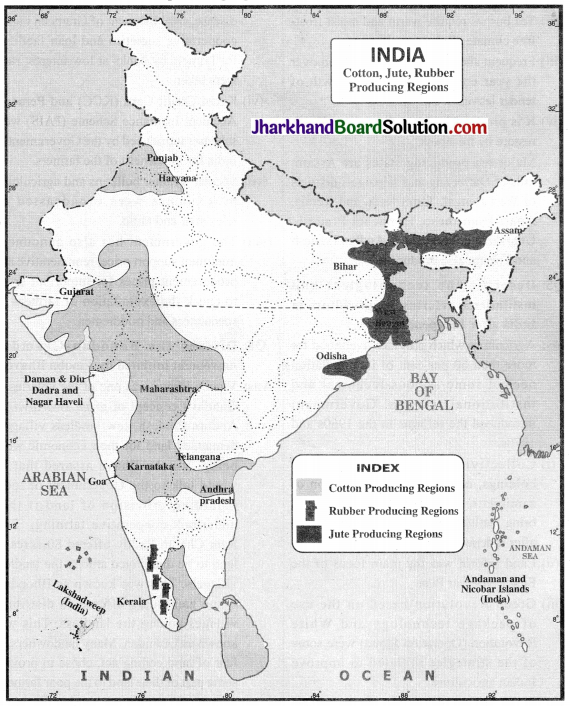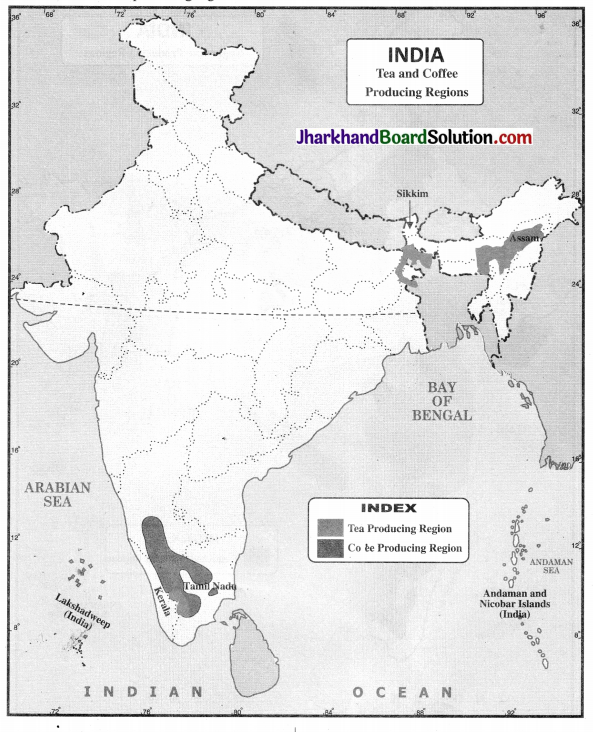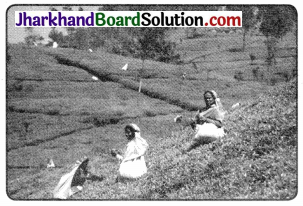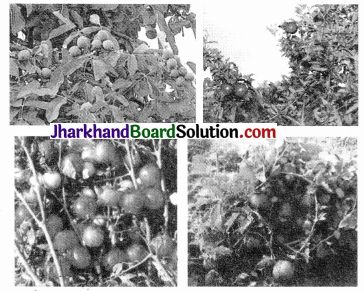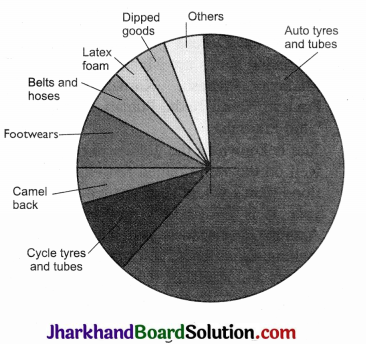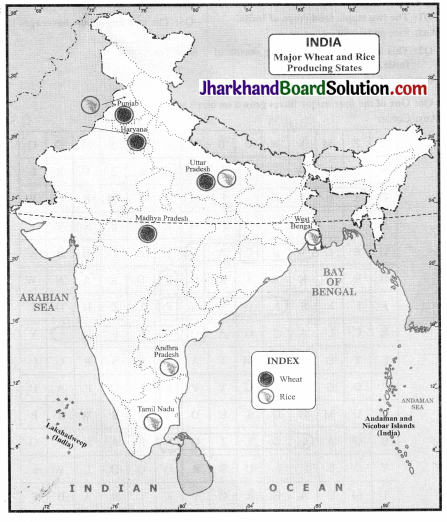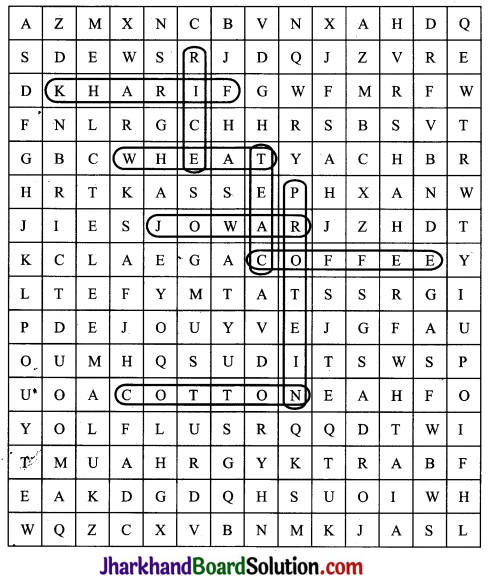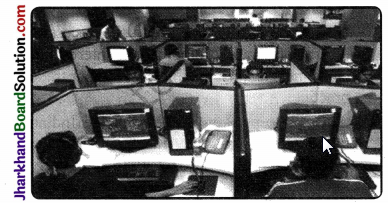JAC Board Class 10th Social Science Solutions Economics Chapter 4 Globalisation and the Indian Economy
JAC Class 10th Economics Globalisation and the Indian Economy InText Questions and Answers
Page 57
Question 1.
Complete the following statement to show how the production process in the garment industry is spread across countries.
The brand tag says ‘Made in Thailand’ but they are not Thai products. We dissect the manufacturing process and look for the best solution at each step. We are doing it globally. In making garments the company may, for example, get cotton fibre from Korea.
Answer:
The brand tag says ‘Made in Thailand’ but they are not Thai products. The manufacturing process is being dissected and looked for the best solution at each step. Products are produced globally. In making garments; the company may, for example, get cotton fibre from Korea, weaving and embroidery from India, buttons from France, ironing in Sri Lanka and sell all over the world.
Page 59
Question 2.
Read the passage given below and answer the questions.
Ford Motors, an American company, is one of the world’s largest automobile manufacturers with production spread over 26 countries of the world. Ford Motors came to India in 1995 and spent a 1700 crore to set up a large plant near Chennai. This was done in collaboration with Mahindra and Mahindra, a major Indian manufacturer of jeeps and trucks. By the year 2014, Ford Motors was selling 77,000 cars in the Indian markets, while another 77,000 cars were exported from India to South Africa, Mexico and Brazil. The company wants to develop Ford India as a component supplying base for its other plants across the globe. Discuss the following factors:
(i) Would you say Ford Motors is an MNC? Why?
Answer:
Yes, Ford Motors is an MNC because its production units are spread across the world with its head office in the USA.
(ii) What is foreign investment? How much did Ford Motors invest in India?
Answer:
Investment made by MNCs to buy assets, such as land, building, machines and other equipment is called foreign investment. Ford Motors invested 1700 crore to set up a plant near Chennai
(iii) By setting up their production plants in India, MNCs such as Ford Motors tap the advantage not only of the large markets that countries such as India provide, but also lower costs of production. Explain the statement.
Answer:
MNCs such as Ford Motors and others set up production in India and other developing countries because of availability of skilled and unskilled labour, favourable government policies, and assured other factors of production. They set up production close to the markets.
(iv) Why do you think the company wants to develop India as a base for manufacturing car components for its global operations?
Answer:
The coijipany wants to develop India as a base for manufacturing car components for its global operations because:
(a) cost of labour and other resources in India.
Answer:
Cost of labour and other resources is low iifelndia. The workers are also able to manufacture or produce the auto parts required for the manufacturing of the car and MNC feels that the Chennai plant can supply to their other plants across the world.
(b) the presence of several local manufacturers who supply auto parts to Ford Motors
Answer:
Cost or labour and production of auto parts is low which makes manufacturing of their cars profitable.
(c) closeness to a large number of buyers in India and China.
Answer:
Cost of transport of auto parts becomes cheap.
(v) In what ways will the production of cars by Ford Motors in India lead to interlinking of production?
Answer:
Ford Motors set up their production plant in Chennai with collaboration of Mahindra and Mahindra, a major Indian manufacturer of jeeps and trucks. They have involved local companies to supply auto parts for their production. This has brought in competition and not only improved the quality of production among the workers in India, but has also helped in interlinking the markets as consumers are now looking for better choices in the markets.
(vi) In what ways is an MNC different from other companies?
Answer:
An MNC is a company with huge financial resources. It has the capacity to expand to other countries. An ordinary company may not have huge financial resources. An MNC owns and controls production in more than one country. An ordinary company owns and controls production in one country, i.e., its home country. An MNC invests in other countries besides its own country. An ordinary company invests only in its home country.
(vii) Nearly all major multinationals are American, Japanese or European, such as Nike, Coca-Cola, Pepsi, Honda, Nokia. Can you giiess why?
Answer:
Nearly all the major MNCs are American, Japanese or European because they are developed nations with immense wealth and power. They have surplus funds and make huge profits, which enable them to utilise the weak policies of the developing nations to set up their production at low costs.
Page 61
Question 3.
What was the main channel connecting countries in the past? How is it different now?
Answer:
Trade was the main channel connecting distant countries. Nowadays, MNCs have set up offices and factories for production in regions where they can get cheap labour and other resources.
Question 4.
Distinguish between foreign trade and foreign investment.
Answer:
The money that is invested by an MNC for buying land, building, machines and other equipment is called foreign investment. Foreign trade is the exchange of goods and services between different countries.
Question 5.
In recent years China has been importing steel from India. Explain how the import of steel by China will affect
(a) steel companies in China.
(b) steel companies in India.
(c) industries buying steel for production of other industrial goods in China.
Answer:
(a) The, steel companies in China will get sufficient supply of steel from the markets in India.
(b) The steel companies in India will expand their production to supply to China, may reduce the cost of production to increase their supply to China and capture a wider space in their market.
(c) Industries buying steel for production of other industrial goods in China may benefit from the import from India as they will get greater choice at a low cost.
Question 6.
How will the import of steel from India into the Chinese markets lead to integration of markets for steel in the two countries? Explain.
Answer:
Export of steel from India to China will lead to integration of markets. The workers from India in the steel manufacturing industry will strive to improve their quality and quantity of production. This will improve their earning and standard of living. The Chinese industrialists will get a variety of options to choose from the variety of steel available to them in the markets at cheap rates.
Page 62
Question 7.
What is the role of MNCs in the globalisation process?
Answer:
Globalisation process has been enhanced by MNCs. MNCs have enabled trade, foreign investment and brought about liberalisation. The setting up of MNCs across various parts of the world, especially in the developing countries has interlinked the economies. This has raised the standards of living of the people of developing countries; they have better options in the markets to choose from. It has also improved the quality and quantity of production of some Indian industries which have tied up with MNCs.
Question 8.
What are the various ways in which countries can be linked?
Answer:
The various ways in which countries can be linked are
- through exchange of goods and services between different countries,
- through foreign investments done by MNCs in various developing countries to set up their production plants,
- immigration of people from one country to another in search of better income, better jobs or better education.
Question 9.
Choose the correct option: Globalisation, by connecting countries, shall result in
(a) lesser competition among producers.
(b) greater competition among producers.
(c) no change in competition among producers.
(b) greater competition among producers.
Answer:
(b) greater competition among producers.
Page 63
Question 10.
Using IT in Globalisation. A news magazine published for London readers is to be designed and printed in Delhi. The text of the magazine is sent through Internet to the Delhi office. The designers in the Delhi office get orders on how to design the magazine from the office in London using telecommunication facilities. The designing is done on a computer. After printing, the magazines are sent by air to London. Even the payment of money for designing and printing from a bank in London to a bank in Delhi is done instantly through the Internet (e – banking)
In the above example, underline the words describing the use of technology in production.
Answer:
- A news magazine published for London readers is to be designed and printed in Delhi.
- The text of the magazine is sent through the Internet to the Delhi office.
- The designers in the Delhi office get orders on how to design the magazine from the office in London using telecommunication facilities.
- The designing is done on a computer.
After printing, the magazines are sent by air to London. - Even the payment of money for designing and printing from a bank in London to a bank in Delhi is done instantly through the Internet (e – banking)
Question 11.
How is information technology connected with globalisation? Would globalisation have been possible without expansion of IT?
Answer:
During the past few years, Information Technology (IT) has played an important role in the process of globalisation. IT has connected the countries across the world. Even the most remote cities and towns are now connected through excellent telecommunication facilities. From banking to placing orders for various products can be done through the Internet. It has transformed the way business has been conducted. E – commerce is the new way to do trade.
Question 12.
What do you understand by liberalisation of foreign trade?
Answer:
Removing trade barriers or trade restrictions set by the government is known as liberalisation of foreign trade.
Question 13.
Tax on imports is one type of trade barrier. The government could also place a limit on the number of goods that can be imported. This is known as quotas. Can you explain, using examples of Chinese toys, how quotas can be used as trade barriers? Do you think this should be used? Discuss.
Answer:
- Quotas can be used to restrict the entry of low quality products into the Indian markets.
- This will ensure quality control of the products. This will also encourage the use of indigenous products.
- Quotas may be used to a certain extent to protect and safeguard the welfare of the small producers and farmers.
Question 14.
Fill in the blanks.
Answer:
WTO was started at the initiative of developed countries. The aim of the WTO is to liberalise international trade. WTO establishes rules regarding international trade for all countries, and sees that these rules are obeyed. In practice, trade between countries is not free and fair. Developing countries like India have been forced by WTO to remove trade barriers, whereas developed countries, in many cases, have continued to provide protection to their producers.
Question 15.
What do you think can be done so that trade between countries is more fair?
Answer:
Trade between countries can be more fair if both countries remove trade barriers and encourage the free exchange of goods and services. The demand and supply in the market should determine the volume of products that should be traded between the countries.
Question 16.
In the above example, we saw that the US government gives massive sums of money to farmers for production. At times, governments also give support to promote production of certain types of goods, such as those which are environmentally friendly. Discuss whether these are fair or not.
Answer:
- The support measures are not justified when they cover goods which enter international market.
- Supporting its own farmers at the cost of international trade cannot be called a fair practice.
- If products are beneficial for the whole world, then every country should follow such practices.
Question 17.
How has competition benefited people in India?
Answer:
Competition has benefited the people in India.
- It has been an advantage to the consumers, particularly the well – off sections in the urban areas. There are greater choices for the consumers who enjoy improved quality and lower prices for several products.
- Therefore, they are able to enjoy higher standardsrif living than before.
- The local companies, supplying raw materials, etc., to the industries set up by MNCs have prospered.
- Indian producers have improved their technology and quality to compete in foreign market.
- The competition has also enabled some of the top Indian companies to become MNCs themselves.
Question 18.
Should more Indian companies emerge as MNCs? How would it benefit the people in the country?
Answer:
Yes, It will benefit the people if more Indian companies emerge as MNCs. As Indian MNCs make profits abroad, it will earn more foreign exchange. It can expand its business which will open employment opportunities for people across various states. They will strive further to improve the quality of products and produce in large volume. The economy of India will improve.
Question 19.
Why do governments try to attract more foreign investment?
Answer:
Governments try to attract more foreign investment to stabilise its financial resources. It pushes the growth of the economy. The taxes received from the foreign investments help the government. New job opportunities, which are created in the country, support many people. The service industry expands with foreign investments.
Question 20.
In Chapter 1, we saw what may be development for one may be destructive for others. The setting of SEZs has been opposed by some people in India. Find out who are these people and why are they opposing it.
Answer:
It is mostly the rural people who oppose to the formation of SEZs as their land is acquired by big MNCs and their livelihoods are taken away from them. They are not qualified to work in the SEZs and feel alienated and ignored by the government. Even small producers, who do not fall within the SEZs but can produce similar products feel they are not protected by the government policies and are overshadowed by MNCs and their brand names.
Question 21.
Rising Competition Ravi did not expect that he would have to face a crisis in such a short period of his life as industrialist. Ravi took a loan from the bank to start his own company producing capacitors in 1992 in Hosur, an industrial town in Tamil Nadu. Capacitors are used in many electronic home appliances including tube lights, television etc. Within three years, he was able to expand production and had 20 workers working under him. His struggle to run his company started when the government removed restrictions on imports of capacitors as per its agreement at WTO in 2001. His main clients, the television companies, used to buy different components including capacitors in bulk for the manufacture of television sets.
However, competition from the MNC brands forced the Indian television companies to move into assembling activities for MNCs. Even when some of them bought capacitors, they wouldprefer to import as the price of the imported item was half the price charged by people like Ravi. Ravi now produces less than half the capacitors that he produced in the year %000 and has only seven workers working for him. Many of Ravi s friends in the same business in Hyderabad and Chennai have closed their units. What are the ways in which Ravi’s small production unit was affected by rising competition?
Answer:
Ravi’s small production was affected adversely by the competition from MNCs. As the government removed restrictions on import of capacitors, the Indian television brands were forced to move into assembling. Ravi lost his clients. As imported capacitors were cheaper, people now preferred to buy imported ones to purchase it from Ravi. Ravi’s friends who were in the same business in Chennai and Hyderabad had to close their units and Ravi feared that he too would have to close down his industry as his production reduced and was not able to recover the cost of production.
Question 22.
Should producers such as Ravi stop production because their cost of production is higher compared to producers in other countries? What do you think?
Answer:
Producers such as Ravi should not close down their production units. They should approach the government to suggest them to make policies and provide subsidies to support small producers. Banks should provide loans at low interest rates to encourage the small producers. They should be inspired to improve their technology and compete in the market.
Question 23.
Recent studies point out that small producers in India need three things to compete better in the market:
1. better road’s, power, water, raw materials, marketing and information network
2. improvements and modernisation of technology
3. timely availability of credit at reasonable interest rates.
(i) Can you explain how these three things would help Indian producers?
(ii) Do you think MNCs will be interested in investing in these? Why?
(iii) Do you think the government has a role in making these facilities available? Why? Discuss.
Answer:
- Better infrastructure will help the producers to compete in the market as they can work more efficiently and make timely deliveries.
- Modernisation of technology will help alleviate the quality of production by the producers. They will also be able to increase the volume of produce.
- Timely availability of credit will enable the producers to purchase good quality raw materials required to increase their competitiveness in the market.
- MNCs will not be ready to invest in these as this will reduce competition and they will lose their share in the market.
- Government should look into these matters to help the indigenous producers rise up and compete in the market. This will in the long run boost the Indian economy.
- Government needs to take steps that WTO rules and regulations, policies are free and fair for all. It should be uniform for all the countries involved in trade practices through WTO.
Question 24.
In what ways has competition affected workers, Indian exporters and foreign MNCs in the garment industry?
Answer:
With the relaxation in government policies to attract MNCs, the workers have lost their regular jobs and are employed ‘flexibly’ by the companies. They not only have to put in long hours of job but their jobs are not secure. They are hired when there is intense work pressure, and may be a$ked to leave when there is not much work.
Question 25.
What can be done by each of the following so that the workers can get a fair share of benefits brought by globalisation?
(a) government
(b) employers at the exporting factories
(c) MNCs
(d) workers
Answer:
(a) Government can introduce policies, rules and regulations for free and fair globalisation.
(b) Employers at the exporting factories can invest in new technology, and try to support the small producers to use the technology to raise their quality and volume of production.
(c) MNCs can give special training to the small producers to use the new technologies and may also offer them financial aid.
(d) Workers need to upgrade themselves regarding the latest technology and create a mindset to meet the challenges of the present century.
Question 26.
One of the present debates in India is whether companies should have flexible policies for employment. Based on what you have read in the chapter, summarise the point of view of the employers and workers.
Answer:
The points of view of the employers and the workers in this regard are as follows:
- Employers: Employers prefer to employ workers ‘flexibly’ when there is work and lay them off when there is no work. This lowers the cost of production.
- Workers: Workers prefer a regular job with regular earning, and other benefits, such as sick leaves, provident, fund, gratuity, etc. Workers prefer secured jobs where they can support their family.
JAC Class 10th Economics Globalisation and the Indian Economy Textbook Questions and Answers
Question 1.
What do you understand by globalisation? Explain in your own words.
Answer:
Globalisation is the process of rapid integration or interconnection betweencountries. Globalisation encourages movement of more and more goods and services, investments and technology between countries. It inspires the movement of people between countries to search for better income, jobs or better education.
Question 2.
What were the reasons for putting barriers to foreign trade and foreign investment by the Indian government? Why did it wish to remove these barriers?
Answer:
The Indian government introduced barriers to foreign trade and foreign investment after Independence for the following reasons:
- To protect the producers within the country from foreign competition.
- The industries were at their nascent stage in the 1950s and 1960s, and competition from imports at that stage would have created obstacles for the emergence of indigenous industries. In the beginning of 1991, there were some far – reaching changes in policy in India.
- The government decided that it was time for the Indian producers to face the competition from producers around the globe.
- The government thought that this competition would encourage the producers within the country to improve their performance and improve their quality.
Question 3.
How wbuld flexibility in labour laws help companies?
Answer:
To attract foreign investment, the Government of India has allowed flexibility in labour laws. This has allowed many of the MNCs to ignore certain rules that aim to protect the workers’ rights. Instead of hiring workers on a regular basis, companies hire workers ‘flexibly’ for short periods when there is intense pressure of work. This is done to reduce the cost of labour for the company.
Question 4.
What are the various ways in which MNCs set up, or control, production in other countries?
Answer:
There are various ways in which MNCs can set up, or control, production in other countries.
1. MNCs are set up close to the market 4 where there is availability of skilled and unskilled labour at low cost; and availability of other factors of production.
2. At times, MNCs set up production jointly with some of the local companies of the countries where it sets up its plant.
3. The most common route for MNC investments is to buy local companies and then to expand production. For example, Cargill Foods, a very large American MNC bought Parakh Foods, which had built a large marketing network in various parts of India. Cargill is now the largest producer of edible oil in India, with a capacity to make 5 million pouches daily.
4. Large MNCs in developed countries place orders for production with small producers. For example, a large number of small producers supply garments, footwear, sports items, etc., to MNCs, which then sell these products under their own brand names to the customers. These large MNCs have huge power to decide the price, quality, delivery and labour conditions for these distant producers.
Question 5.
Why do developed countries want developing countries to liberalise their trade and investment? What do you think should the developing countries demand in return?
Answer:
- Developed countries want developing countries to liberalise their trade and investment because developed countries believe that all barriers to foreign trade and investment are harmful.
- Trade between countries should be ‘free’ and all countries in the world should liberalise their policies.
- The developed countries can set up their plants and offices in the developing countries at lower costs, sell their products at a higher price and earn profits.
- The developing countries should in return demand for the labour laws be followed strictly to protect the rights of the labourers.
- As the MNCs earn profits, they should be levied taxes and there should be no relaxation in it.
- Trade practices should be fair. The developed countries should stop giving subsidies to their agricultural sector. The developed countries should not also keep any trade barriers.
Question 6.
“The impact of globalisation has not been uniform.” Explain this statement.
Answer:
The impact of globalisation has not been uniform. It has both positive and negative influences on the economy and life of the people.
- It has been of an advantage to consumers, particularly the well-off sections in the urban areas. There is greater choice before the consumers who now enjoy improved quality and lower prices for several products.
- People can now enjoy higher standards of living than was possible earlier. MNCs have established industries, such as cell phones, automobiles, electronics, soft drinks, fast food or services such as banking in urban areas. The well-off people have the purchasing power to afford these products.
- New jobs have also been created in these industries and services. Local companies supplying raw materials, etc., to these industries have also benefited.
- Globalisation has also helped several of the top Indian companies to benefit from the increased competition.
- They have invested in newer technology and production methods and also raised their production standards. It has enabled some large Indian companies to emerge as multinationals themselves. For example, Tata Motors, Infosys, Asian Paints, Sundaram Fasteners etc.
- For a large number of small producers and workers, globalisation has posed major challenges.
- Many small manufacturers have been hit hard because of competition. Several units have closed down rendering many workers jobless.
- In many industries, employers prefer to hire workers ‘flexibly’. This has made the workers jobs insecure.
- The workers have to put in long hours of work and may also need to do night shifts, but their wages are very low.
Question 7.
How has liberalisation of trade and investment policies helped the globalisation process?
Answer:
- With liberalisation, goods could be imported and exported easily. Foreign companies can now set up factories and offices in India and in other developing countries.
- Businesses are allowed to make decisions freely about what they wish to import or export.
- Liberalisation has boosted foreign trade, which has resulted in connecting the markets or integrating markets in different countries.
- For example, Ford Motors, an American company and one of the world’s largest automobile manufacturers set up a large plant in Chennai in collaboration with Mahindra and Mahindra, which is a major Indian manufacturer of jeeps and trucks. not only sells cars in India but also exports cars from India to South Africa, Brazil and Mexico.
Question 8.
How does foreign trade lead to integration of markets across countries? Explain with an example other than those given here.
Answer:
- Foreign trade creates an opportunity for the producers to reach beyond the domestic markets.
- Producers can sell their produce not only in markets located within the country but can also compete in markets located in other countries of the world.
- For the buyers, there is a wide variety of choice in the markets. They can prefer domestically produced goods to foreign imported goods.
- With tjie opening of trade, goods travel from one market to another. Choice of goods in the market rises. Prices of similar goods in the two markets tend to become equal.
- Producers in the two countries now closely compete against each other even though they are separated by thousands of miles. Foreign trade thus results in connecting or integrating the markets in different countries.
- For example, the Kirloskar Group has established itself as the manufacturer of indigenous technology and industry. It was the manufacturer of India’s first iron plough. One of its major successes was its affiliation with Toyota Motor Corporation of Japan in 1997, which boosted the growth of the Indian industry.
Question 9.
Globalisation will continue in the future. Can you imagine what the world would be like twenty years from now? Give reasons for your answer.
Answer:
Globalisation has both positive and negative effects on the society.
- WTO has initiated the process of globalisation. Removing trade barriers or trade restrictions set by the government has brought about liberalisation.
- This has encouraged foreign trade connecting the markets or integrating the markets in different countries.
- Twenty years from now, people will have more choices of products and services. More jobs may open up for the people. While more MNCs from developed countries may be found in India, many more of our Indian companies may become MNC themselves.
- The government should have policies that should look into the interests and welfare of the entire nation and its citizens.
- It should support the weaker section or the small producers so that they are able to face the competition and gradually improve and rise in the market.
Question 10.
Supposing you find two people arguing: One is saying globalisation has hurt our country’s development. The other is telling, globalisation is helping India develop. How would you respond to these arguments?
Answer:
Both arguments are true to a certain extent.
1. Negative aspects of globalisation:
Globalisation has posed as a major issue for the small producers and workers. Many small – scale industries have shut down rendering many workers jobless.
- With the liberalisation, government has allowed the ‘flexibility’ of labour laws. The companies do not need to follow all the labour laws that protect the workers’ rights. Instead of hiring workers on a regular basis, companies hire workers ‘flexibly’ for short periods when there is intense pressure of work.
- This reduces the cost of labour for the company. Most of the workers today are employed in the unorganised sector.
2. Positive aspects of globalisation:
- With liberalisation, came globalisation. This invited many MNCs to spread their business in India.
- The Central and State governments have taken several steps to attract foreign investors and foreign companies. They have set up SEZs for MNCs, which have high-class facilities. The companies do not have to pay taxes for the initial five years. The Indian government has also allowed ‘flexibility’ in the labour laws.
- Globalisation has been an advantage to the well – off sections in the urban areas. It has opened many job opportunities for them. They are able to make better choices in the markets as they are flooded with foreign products. The standards of living have risen.
- Local companies supplying raw materials to MNCs have prospered. Even the large Indian companies have benefited from the competition. They have been able to raise their production standards.
- Some have been able to gain from foreign collaborations. Many of them, such as Infosys, Asian Paints, Sundaram Fasteners, Tata Motors, Ranbaxy, etc., have become MNCs themselves.
Fill in the blanks.
Question 11.
Indian buyers have a greater choice of good? than they did two decades back. This is closely associated with the process of ………….. Markets in India are selling goods produced in many other countries. This means there is an increasing ………… with other countries. Moreover, the rising number of brands that we see in the markets might be produced by MNCs in India. MNCs are investing in India because ………….. While consumers have more choices in the market, the effect of rising …………. and ………. has meant greater ………….. among the producers.
Answer:
Indian buyers have a greater choice of good? than they did two decades back. This is closely associated with the process of globalisation. Markets in India are selling goods produced in many other countries. This means there is an increasing trade with other countries. Moreover, the rising number of brands that we see in the markets might be produced by MNCs in India. MNCs are investing in India because production cost is cheaper. While consumers have more choices in the market, the effect of rising demand and purchasing power has meant greater competition among the producers.
Question 12.
Match the following.
| (i) MNCs buy at cheap rates from small producers | (a) Automobiles |
| (ii) Question uotas and taxes on imports are used to regulate trade | (b) Garments, footwear, sports items |
| (iii) Indian companies which have invested abroad | (c) Call centres |
| (iv) IT has helped inspreading of production of services | (d) Tata Motors, Infosys, Ranbaxy |
| (v) Several MNCs have invested in setting up factories | (e) Trade barriers in India for production |
Answer:
| (i) MNCs buy at cheap rates from small producers | (b) Garments, footwear, sports items |
| (ii) Question uotas and taxes on imports are used to regulate trade | (d) Trade barriers in India for production |
| (iii) Indian companies which have invested abroad | (e) Tata Motors, Infosys, Ranbaxy |
| (iv) IT has helped in spreading of production of services | (c) Call centres |
| (v) Several MNCs have invested in setting up factories | (a) Automobiles |
Question 13.
Choose the most appropriate option.
(i) The past two decades of globalisation has seen rapid movements in
(a) goods, services and people between countries
(b) goods, services and investments between countries
(c) goods, investments and people between countries
Answer:
(a) goods, services and people between countries
(ii) The most common route for investments by MNCs in countries around the world is to
(a) set up new factories
(b) buy existing local companies
(c) form partnerships with local companies
Answer:
(b) buy existing local companies
(iii) Globalisation had led to improvement in living conditions
(a) of all people
(b) of people in the developed countries
(c) of workers in the developing countries
(d) none of the above
Answer:
(c) of workers in the developing countries
Project Activity Based Questions
Question 1.
Take some branded products that we use everyday (soaps, toothpaste, garments, electronic goods, etc.). Check which of these are produced by MNCs.
Answer:
Hints:
- Display the products carefully on a table.
- Study the labels of the products in detail. Each product will have a Registered Trademark mentioning the name of the company and the country of origin.
- Now classify the products produced by foreign MNCs and Indian MNCs.
Question 2.
Take any Indian industry or service of your choice. Collect information and photographs from newspapers, magazine clippings, books, television, internet, interviews with people on the following aspects of the industry:
(a) Various producers/companies in the industry
(b) Is the product exported to other countries
(c) Are there MNCs among the producers
(d) Competition in the industry
(e) Conditions of work in the industry
(f) Has there been any major change in the industry in the past fifteen years
(g) Problems that people in the industry face
Answer:
Hints:
(a) With the help of parents, teachers and elders, choose an industry which is present near your school or in your town or city.
(b) With the help of school authorities, make an appointment to visit the industry.
(c) While making the appointment, describe in points about the purpose of the visit and information that will be required. This will not only save precious time of yours but also the industry management, which usually keeps very busy throughout the day. They can also keep the reports and data ready which they can share with you.
(d) Prepare a detailed questionnaire for the various departments of the industry that you may visit. If it is too detailed, it may be forwarded to the management of the industry before, so that it can be filled beforehand. The questionnaire should be crisp and short, with only objective questions, with multiple choices or fill in the blanks.
(e) Be disciplined while questioning, going through reports, etc. A small group of 4 to 5 students can be assigned as a team to deal with various aspects of the industry. Instead of all talking together, the team leader can initiate the discussion.
(f) Any photographs taken by the students in the industry should be done with prior permission of the management of the industry.
(g) Students can refer to secondary reports as mentioned in the textbook to gather information about the industry.
![]()
![]()
![]()
